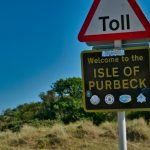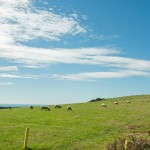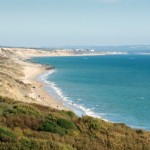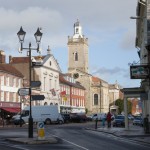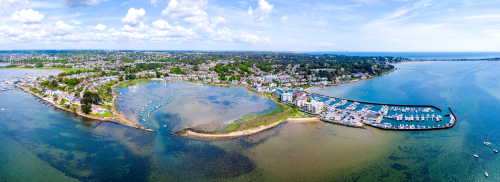
Poole in Brief
Poole is a large coastal town and seaport in the county of Dorset on the south coast of England. The town is 21 miles (34 km) east of Dorchester and connects with Bournemouth to the east. In 2011, the town’s population was recorded as 147,645, which made it the second-largest settlement in Dorset after Bournemouth. In 2019, the town became part of the South East Dorset conurbation, established along with nearby Bournemouth and Christchurch. The conurbation is the largest urban area in the UK without city status.
A Fleeting History
Early Days
The Poole area was reputedly first settled some 2,500 years ago. Around 300 BC, Celtic tribespeople now known as the Durotriges settled around Poole Harbour. The marshlands they inhabited probably contributed to their name of Durotriges, which translates as ‘water dwellers’.
Poole is one of the places on Britain’s south coast where the Romans landed during their 1st-century conquest of the country. Future Roman Emperor, Vespasian, landed the 2nd Augustan Legion at Poole harbour in 43 AD. He went on to found Hamworthy, which lies just west of the modern-day town centre. The Romans used the anchorage at Poole throughout their 400-year occupation of Britannia.
The Saxon and Vikings
Following the 7th century Saxon invasion of southern Britain, Poole became part of the newly established Kingdom of Wessex. Wareham, 6 miles from Poole across Arne Bay, became an important Saxon stronghold. By 875, the Danes had control of Wareham but their tenure was short-lived. In 876, an army led by the Anglo-Saxon ‘Alfred the Great’ recaptured Wareham. The Viking fleet, anchored in Poole Harbour, attempted a hasty retreat. However, most of their ships were lost in a huge storm just off the coast.
In 1015, the Danes returned to England under the command of King Canute. He chose to land his fleet at Poole harbour. They pillaged the local area before heading along the coast to attack London. Poole remained a small fishing village until well after the Norman Conquest.
The Late Middle Ages
The earliest known use of the name ‘Poole’ was in the 12th century. That’s when the town began to emerge as an important port on the back of its wool trade. In 1248, Lord of the Manor, Sir William Longespee the Younger, granted the Poole certain rights under the Longespee Charter. The charter was granted to the town in order to raise funds for Sir William’s Middle East crusade. Poole was given the right to appoint a mayor, hold court, and obtain exemptions on import duties. In 1250, Sir William was killed at the Battle of Mansurah in Egypt.
In 1405, a combined French and Spanish naval fleet attacked Poole. They burnt and looted the town in reprisal for the exploits of local privateer and smuggler Captain Henry Paye. He had plundered and caused mayhem along the Normandy coast through to the Bay of Biscay and Cape Finisterre. The European forces looted goods and raised mayhem before being driven back to sea by Poole’s townsfolk. Paye hadn’t been present in Poole during the raid but his brother was amongst those killed. Despite the setback, Poole continued to prosper and soon became the biggest port in Dorset. In 1433, Poole was granted ‘Stable Port’ status by King Henry VI, enabling the town to further flourish.
Tudor & Stuart Times
At the start of the 16th century, Poole set up trade links with North America. In particular, it established a strong fishing trade with Newfoundland. By the mid-16th century, large quantities of salt were being landed at Poole. Essentially, to supply the fishing industry.
In 1568, Poole was granted the status of County Corporate by the Great Charter of Queen Elizabeth I. The Charter gave the town separation from the rest of Dorset and the title of ‘the County of the Town of Poole’. The title was retained by the town until the 18th century.

The ruins of the historic Corfe Castle
During the English Civil War, Poole was staunchly Parliamentarian, whilst most of Dorset sided with the Royalists. Poole was constantly under the threat of attack but remained a Cromwell stronghold throughout the war. In 1646, with the Royalists on the verge of defeat, a Poole-based Parliamentary laid siege to Corfe Castle at nearby Wareham.
Up to that point, the castle had been successfully been defended throughout the war by Dame Mary Bankes. Parliament ordered the destruction of the castle to ensure that it could never be used again as a Royalist fort. However, Mary’s bravery did not go unrecognised. Her victors presented her with the keys of the castle as a memento. In 1660, the restoration of the monarchy saw Poole’s defences demolished on the orders of Charles II.
The 18th & 19th Centuries
The early 18th-century to early 19th-century period was Poole’s golden age in its fishery trade with Newfoundland. During this time, more ships were trading out of Poole with North America than any other part of Britain. The new prosperity that the trade brought supported much of the development of the ‘Old Town’. This saw many of the town’s Medieval dwellings replaced with fine Georgian townhouses.
The end of the Napoleonic Wars and the ‘War of 1812’ with America, had big implications for Poole. It saw the end of Britain’s monopoly over the Newfoundland fisheries. Emerging nations were able to provide cheaper services than their British counterparts, which resulted in a rapid decline in the country’s fishing trade.
In 1847, the arrival of the railway at nearby Hamworthy also affected Poole. Larger ships with deeper draughts were also becoming the norm. These events along with a lack of investment in the dock facilities saw Poole’s status as a major port swiftly decline. The port was soon playing second fiddle to the likes of Plymouth, Southampton and Liverpool. In 1895, an Act of Parliament attempted to rescue the situation. The newly Poole Harbour Commissioners (PHC) was handed the responsibility of regulation, maintenance, and improvement of the docklands.
The Early 20th Century
At the beginning of the 19th century, 90% of the town’s workforce was employed either directly or indirectly by the port. By the end of the century, this had dropped dramatically to 20%. Furthermore, Poole did not develop as a tourist resort like many of the neighbouring towns and villages. However, it did especially benefit from the growth of Bournemouth and its subsequent demand for goods.
WWI saw an increase in activity of the harbour, mostly from the import of agricultural produce from Jersey. In 1916, the Royal Naval also established a local cordite factory, which saw iron pyrite being imported from Spain and Norway. In WW2, the Dorset Lake Shipyard was established at Hamworthy to build minesweepers for the war effort. Poole harbour was also one of the locations from which the Normandy Invasion was launched by the Allied Forces in 1944.
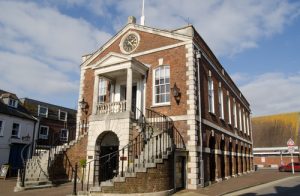
The Guildhall is one of the town’s historic buildings
The Modern Era
The post-war economic decline meant there was no major redevelopment of Poole until the 1960s. Then, large slum areas were demolished and replaced with modern public housing. In 1969, Poole General Hospital was opened along with the Arndale Shopping Centre (now the Dolphin Centre). However, many of Poole’s historic buildings were demolished in the redevelopment.
A major 1974 development saw the RNLI move its headquarters from London to Poole. In 1975, a conservation area was created around the town centre to preserve its remaining historic buildings.
Recent investment in the port facilities at Hamworthy has enabled Poole to become one of the busiest ports in the UK. Current imports include steel, timber, bricks, fertiliser, grain and aggregates, while clay, sand and grain are major exports. Commercial ferry operators run regular passenger and freight services from Poole to Cherbourg, St Malo and the Channel Islands. With one of the largest registered fleets in the UK, Poole has also retained a thriving fishing industry. The town is particularly renowned for its shellfish, crab and lobster fishing. Additionally, one of Europe’s largest on-shore oil fields lies under the Harbour and Poole Bay.
The financial, service and digital sectors, also thrive in and around the Poole. Tourism is also an important part of the local economy.
Getting to Poole
Located approximately 100 miles South West of London the road links to Poole are excellent. Just take the M3, M27, and A31, or go via the A35, if you’re travelling from the East or West of the country. If you’re travelling by rail then South Western Railway provide a regular service from London Waterloo. The journey time is about 2 hours. There are also direct trains to/from many other destinations across the country.
National Express, Stagecoach and Megabus, amongst others, operate coach services to and from Poole. All coaches and cross-country buses arrive in the centre of Poole next to the train station. Bournemouth (BOH) Airport is located 12 miles southwest of Poole. It operates multiple routes to and from Europe.
A few famous sons
- John Le Carre – the internationally best-selling spy novelist was born in Poole in 1931. He was a former British Security Service (MI5) and the Secret Intelligence Service (MI6) agent during the 1950s and 1960s.
- Greg Lake (1947 – 2016) – was a famed singer, songwriter, bassist, guitarist and record producer who was born in Poole in 1947. He is perhaps best remembered for being a member of the progressive rock supergroup Emerson, Lake & Palmer. Sadly, Greg died from cancer in 2016, aged 69.
- Henry Paye (1360 – 1419) – also known as Harry, Page or Arripaye, was an infamous maritime privateer and smuggler. Born in Poole around 1360, he eventually became Commander of the Cinque Ports Fleet.
Did you know?

- The first-ever Scout Camp, which led to the formation of the worldwide Scout movement, took place on Poole’s Brownsea Island in 1907.
- The original computer ERNIE used in the UK’s Premium Bond draw was designed and made in Poole. The first draw was made on 1 June 1957.
- Bournemouth University is actually located in Poole.
- Brownsea Island is home to one of England’s few colonies of red squirrels.
- Poole has the largest natural harbour in Europe.
Sport in Poole
Poole Town FC
Poole Town FC currently competes in the Southern League Premier Division South. Nicknamed ”The Dolphins”, they play their home games at the Tatnam Ground, which has a capacity of 2,500.
Poole Pirates
Poole Pirates are a motorcycle speedway team that compete in the SGB Championship. Poole Stadium (Wimborne Road Stadium) has been the Pirates home track since the creation of the club in 1948.
Things to do in Poole
- Brownsea Island – is located in Poole Harbour and has great views across to the Purbeck Hills. It has a thriving natural habitat, which includes woodland, heathland and a lagoon, home to a mix of wildlife, including the red squirrel. There’s also an outdoor centre which offers a range of activities and overnight accommodation at its eco-adventure campsite.
- Sandbanks Beach – is one of the UK’s top-rated beaches. With its immaculate golden sands, it has held the highly coveted international Blue Flag for the past 30 years. There’s a designed area for barbecues and swimmers, as well as crazy golf, a children’s play area and the Sandbanks Beach Cafe.
- Greenslade Pleasure Boats – offer boat trips from Poole Quay to Brownsea Island, Wareham, around the harbour and along the coast. Boats depart from Poole Quay from 10.00 am onward and then every 30 minutes throughout the day.
- Splashdown – is a themed waterpark with the usual slides and rides. Located at Tower Park, there’s plenty of parking. While it’s open all year round, days and times do vary depending on the season.
Sandbanks Chain Ferry – is operated by the Bournemouth-Swanage Motor Road and Ferry Company. The ferry operates between Sandbanks (5 miles from Poole), and Swanage, which is a 25-mile road journey – so not bad for a quid, each way. You can chill out and take in the great views of Sandbanks Beach and Brownsea Island.
Things to see in Poole
- Farmer Palmer’s Farm Park – is a popular award-winning family attraction located just outside Poole. Children can get close up and hands-on with a variety of farm animals. If that’s not enough, there’s also bouncy castles and a Wendy House play area. For the adults, there’s a tranquil woodland walk, a restaurant and better still, a licensed bar.
- Oceanarium – is an aquarium located just a few miles in Bournemouth. A great day out for all the family, there’s otters, sharks, turtles, stingrays, piranha, penguins and more.
- Corfe Castle – is located only 6 miles from Poole as the crow flies but it’s a 15-mile journey by road. You can also get there by taking the Sandbanks ferry and a short steam train journey from Swanage. There’s been a fort at the site since Saxon times. The now a mere 1, 000 years old ruined castle, the place is steeped in history (see; A Fleeting History). There’s a regular programme of re-enactment events between April and September.
Where to Stay?
There’s a good choice of accommodation in Poole but staying in nearby Bournemouth is also an option as prices are similar in both towns. For 2 adults sharing, expect to pay £50 – £ 90 per night for a B & B/Guesthouse. For a hotel it’s £90 – £150; and for a luxury hotel £150 plus. Holiday lets and apartments offer an alternative place to stay but there is a greatly variable in prices depending on the standard and/or location.
Thinking of moving to Poole?
Thinking of moving to Poole? The average property price in the Poole area for July 2020 stood at approximately £349,300. This represents a fall of about 8 % on the average price paid in the last 12 months. In terms of property types, flats were selling for an average of £296,700, terraced houses for £257,500 and semi-detached for £271,800.
Thinking of a Staycation?
Are you thinking of holidaying in the UK sometime soon? If so, why not check out some of our other travel guides for some staycation ideas. I think you’ll be surprised at the variety of great things to do in the UK’s fairly green and mostly pleasant land.
